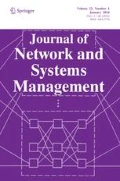Abstract
The increasing complexity in size and heterogeneity of networks requires the development of network management tools that are less dependent on human intervention. Many tasks in network management consist of the coordination and execution of multiple activities across different network platforms. In the first part of this paper we introduce a language to write Distributed Action Plans (DAPs). A DAP is meant to specify one of these distributed network management tasks. To run these plans we use policy agents. These are agents that can be specified in PDL, an event-driven programming language developed at Bell Labs to perform policy-based network management. The second half of the paper shows how DAPs are translated into PDL and describes the policy agent system that executes these DAPs.
Similar content being viewed by others
REFERENCES
R. Wies, Policies in network and system management—formal definition and architecture, Journal of Network and System Management, 2(1):63–83, 1994.
M. Z. Hasan, An active temporal model for network management databases, IFIP/IEEE fourth International Symposium on Integrated Network Management, pp. 524–535, Santa Barbara, California, May 1995.
A. Leinwand and K. F. Conroy, Network Management: A Practical Perspective, Addison Wesley, Second Edition, 1996.
J. Lobo, R. Bhatia, and S. Naqvi, A policy description language, Proc. of AAAI/IAAI, pp. 291–298, Orlando, Florida, July 1999.
The Workflow Management Coalition, Terminology and Glossary, Technical Report WFMC-TC-1011, The Workflow Management Coalition, June 1996.
S. Abiteboul, V. Vianu, B. Frodham, and Y. Yesha, Relational transducers for electronic commerce, Proc. 17th ACM SIGACT/SIGMOD Symposium on Principles of Database Systems, Seattle, Washington, June 1998, pp. 179–187.
J. D. Ullman, Principles of Database and Knowledge-Base Systems, Vol.I, Computer Science Press, 1988.
M. Kamath and K. Ramamritham, Failure handling and coordinated execution of concurrent workflows, International Conference on Data Engineering, Orlando, Florida, pp. 334–341, February 1998.
M. Kohli and J. Lobo, Workflow in Network Management, Technical Report, Bell Labs, 1999.
R. Bhatia, J. Lobo, and M. Kohli, Policy evaluation for network management, Proc. INFOCOM 2000, Tel Aviv, Israel, pp. 1107–1116, March 2000.
J. Chomicki, J. Lobo, and S. Naqvi, Conflict resolution using logic programming, IEEE Transactions on Knowledge and Data Engineering, Vol.15, No.(1), pp. 244–249, 2003.
A. Virmani, J. Lobo, and M. Kohli, Netmon: Network management for the SARAS softswitch, Proc. IEEE/IFIP Network Operations and Management Symposium, Honolulu, Hawaii, pp 803–816, April 2000.
T. C. Son and J. Lobo, Reasoning about policies, Proceedings of the AAAI Spring Symposium on Anser Set Programming: Towards Efficient and Scalable Knowledge Representation and Reasoning, pp. 210–216, March 2001.
M. P. Singh, Formal Aspects of Workflow Management, Part 1: Semantics, Technical Report TR–96–08, North Carolina State University, 1997.
H. Davulcu, M. Kifer, C. R. Ramakrishnan, and I. V. Ramakrishnan, Logic based modeling and analysis of workflows, Proc. 17th ACM SIGACT/SIGMOD Symposium on Principles of Database Systems, Seattle, Washington, pp. 25–33, June 1998.
A. Bonner, Workflow, transactions and datalog, Proc. 18th ACM SIGACT/SIGMOD Symposium on Principles of Database Systems, Philadelphia, Pennsylvania, pp. 294–305, May-June 1999.
A. Bonner and M. Kifer, Concurrency and communication in transaction logic, Joint International Conference and Symposium on Logic Programming, MIT Press, Bonn, Germany, pp. 142–156, September 1996.
C. Boutilier and R. I. Brafman, Planning with concurrent interacting actions, Proc. of the National Conference on Artificial Intelligence, AAAI Press, Providence, Rhadhe Island, pp. 720–726, July 1997.
D. S. Weld, An introduction to least commitment planning, AI Magazine, Vol.15, No.4, pp. 27–61, 1994.
Author information
Authors and Affiliations
Corresponding author
Rights and permissions
About this article
Cite this article
Kohli, M., Lobo, J. Realizing Network Control Policies Using Distributed Action Plans. Journal of Network and Systems Management 11, 305–327 (2003). https://doi.org/10.1023/A:1025715306518
Issue Date:
DOI: https://doi.org/10.1023/A:1025715306518




